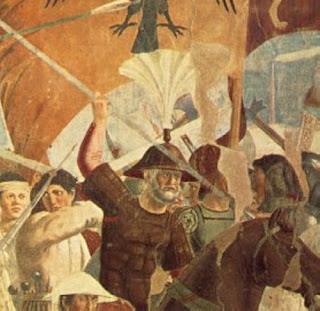I gave a light-hearted paper on the toupha-toufa this weekend at the Medieval Academy of the Pacific in Tacoma, Washington, to answer the question: what did Gozzoli think he was doing with this feathered crown? He clearly has heard of the diadem with feathers traditionally worn by the Eastern emperor in a triumph, a diadem bearing a circle of peacock feathers, called a toupha. I didn't answer it adequately there.
It is a representation -- not a portrait -- of John VIII Palaiologos in procession in Florence for the Council of Union, painted between 1459 and 1461 for the Medici Chapel in their palazzo, although Gozzoli was in Florence and saw John in 1439. John came for humiliation, not a triumph, but Gozzoli has turned the procession into a triumph.
It is a representation -- not a portrait -- of John VIII Palaiologos in procession in Florence for the Council of Union, painted between 1459 and 1461 for the Medici Chapel in their palazzo, although Gozzoli was in Florence and saw John in 1439. John came for humiliation, not a triumph, but Gozzoli has turned the procession into a triumph.
In preparation for this paper, a few images new to me turned up. For want of writing time, I am kindly making these images available here. This first is carved on an 11th-C ivory box that has various representations of emperors or horseback. Since the toupha is generally associated with a military triumph, it is odd to see it in the context of hunting and I am a bit curious about the way the emperor sits his horse.
The next one I showed before, a toupha portrayed in an 11-th C fabric found in the tomb of a German bishop, but its perspective may help to explain the shape of the headdress on Cyrenius, Governor of Syria, in the 14th-C mosaic in the Kariye Djami in Istanbul.
Do the striped feathers in Gozzoli's interpretation of the toupha have anything to do with the striped feathers on Ag. Alexandros of Pydna, shown here in the Cave of the Theotokos at Prespa? Especially as this Ag. Alexandros is wearing, like Gozzoli's, a short-sleeve robe. This robe is covered with Palaiologan double-headed eagles. He seems to have originated as one of those martyred soldiers, but it does look as if, being in northern Greece, a sainted soldier Alexandros -- soldiers are often shown wearing helmets with a crest which is called a toupha -- became conflated with Alexander the Great, and an emperor is entitled to a right royal toupha and robe.
Another Ag. Alexandros, from Ag. Athanasios in Kastoria.
Finally, the toupha Piero della Francesca painted about 1447 in his glorious fresco sequence on the Legend of the True Cross in S. Francesco in Arezzo. Ten years ago I visited the church when the frescos were being restored, and was taken up on a scaffolding so that I was as close to the hand of Piero as I am to my computer screen. It represents the emperor Heraclius at the moment of victory.
Piero probably took his toupha from a Roman or Greek image, such as this 500BC toupha I photographed through a reflective glass case in a museum in northern Greece whose name I cannot remember. I was on a tour and it was a three-museum day.
So at the conference, in the question period after the panel I was on, Linda Williams of the University of Puget Sound made a suggestion that elegantly finished off my explanation of the crown as a toufa. She said that the Medici coat of arms had feathers on it.
Looking into that, I find that the Medici arms -- Cosimo and Lorenzo provided the pope with the cash to finance his council and the expenses of the 700 Greeks -- bore a ring mounted by three ostrich feathers. And look at this Medici marriage tray at the Metropolitan Museum of Art with red, green, yellow, and white feathers around the inner rim of the frame.
Now look again at the colors of the feathers around John's crown -- red, green, and white, with gold replacing the yellow -- and see if you don't think that Gozzoli has adroitly transformed the gawky peacock-feather imperial toupha into a graceful compliment to his patron.













